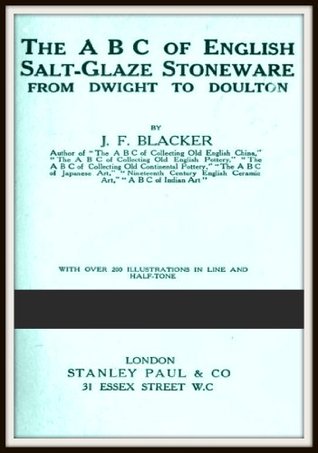Full Download The A B C of English Salt Glaze Stoneware from Dwight to Doulton - James F. Blacker | ePub
Related searches:
The A B C of English Salt-glaze Stoneware From Dwight to
The A B C of English Salt Glaze Stoneware from Dwight to Doulton
The A B C of English salt-glaze stoneware from Dwight to
The ABC of English Salt-Glaze Stoneware: From Dwight to
The ABC of English salt-glaze stoneware from Dwight to
The ABC of English Salt-Glaze Stone Ware; From Dwight To
4987 218 3676 4498 4944 2343 3970 537 2663 3490 2315 260 803 1827 799 4562
Salt glazed stoneware is pottery with a translucent glaze which has a slightly orange-peel texture the salt glaze is formed by throwing salt into the kiln during the higher temperature part of the firing process. Sodium from the salt reacts with silica in the clay body to form a glassy coating of sodium silicate, hence salt glazed.
English brown salt-glazed stoneware is most commonly found in drinking vessel and serving forms.
Find plates, bowls and mugs in classic styles and bold colors, perfect for entertaining.
Fiesta was introduced at the annual pottery and glass exhibit in pittsburgh, pennsylvania in january 1936. It was not the first solid color dinnerware in the us; smaller companies, especially bauer pottery in california, had been producing dinnerware, vases, and garden pottery, in solid color glazes for the better part of a decade by the time fiesta was introduced to the market.
Information or research assistance regarding english ceramics is frequently requested from the smithsonian institution. The following selected bibliography has been prepared to assist those interested in this topic.
Salt glaze pottery is stoneware with a glaze of glossy, translucent and slightly orange-peel-like texture which was formed by throwing common salt into the kiln during the higher temperature part of the firing process. Sodium from the salt reacts with silica in the clay body to form a glassy coating of sodium silicate. The glaze may be colourless or may be coloured various shades of brown.
Salt-glaze or salt glaze pottery is pottery, usually stoneware, with a glaze of glossy, translucent and slightly orange-peel-like texture which was formed by throwing common salt into the kiln during the higher temperature part of the firing process. Sodium from the salt reacts with silica in the clay body to form a glassy coating of sodium silicate. The glaze may be colourless or may be coloured various shades of brown, blue, or purple.
The a b c of english salt-glaze stoneware from dwight to doulton [blacker, j f] on amazon. The a b c of english salt-glaze stoneware from dwight to doulton.
Com: the abc of english salt-glaze stone ware; from dwight to dalton: publishing info: 1st edition description: brown cloth with illustration and titles to front and spine. Illustrated throughout with black and white plate and in text drawings.
A significant english manufacturer of salt glaze pottery was john dwight at the fulham pottery, which he founded in 1672. [14] [15] in a related patent application, which was granted in 1671, he also claimed to have discovered the mystery of transparent earthenware commonly knowne by the name of porcelaine or china and persian ware.
18th century antique english porcelain manufacturers followed in the steps of the french in that the vast majority of porcelain produced was of the soft paste type. In 1567 two european potters arrived in england, from holland. They brought with them the production methods for tin-glaze pottery manufacture.
Today, salt glazing is called vapor glazing, a name the technique received from the sodium vapors caused by the salt that the potter throws into the kiln when.
Feb 28, 2015 white salt glaze stoneware was manufactured for a hundred year period and other british pottery centers (edwards and hampson 2005:24).
Salt-glaze, unlike the glazes used in today’s manufacturing processes, could leave little lumps and bumps. While the glaze may have left the surface relatively smooth with a shiny almost glass-like finish, small lumps could still develop as the glaze cured. These lumps may not be highly visible, but they can still be felt when touched.
Williamsburg pottery mug stein gray salt glazed tankard cobalt leaf 6 tall new only displayed in a cabinet.


Post Your Comments: